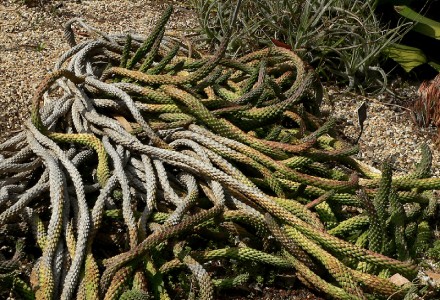Photographer: Stan Shebs
CC License: https://bit.ly/1p2b8Ke
Medusas Head Facts
- Perhaps most notably, the astounding Medusas Head remains one of the most visually unique plants currently known to exist. The visually astonishing species also remains known to some people around the world as the Euphorbia Caput-Medusae.
- This incredible work of Nature further represents a remarkably fascinating succulent placed in the genus Euphorbia. The highly distinctive common name of the species derives from its amazing appearance. That fact’s quite understandable!
- Firstly, this amazing plant evolved to present a short, central caudex. Secondly, however, comes the most amazing part of its nature. This part of the plant immediately spreads into a seething mass of serpent-like items which resemble the head of Medusa.
- Its wonders don’t simply stop here, though. That’s due to the fact that yet another surprising fact pertains to this stunning species. Quite surprisingly, thanks to the efforts of mankind, the species has also been introduced to the Netherlands.
- This artificial introduction of the astonishing plant into this non-native area occurred sometime around the year 1700. For the moment, the IUCN thankfully does not have a listing for the Medusas Head on its published Red List of Threatened Species.
- Many experts around the world nevertheless consider this marvel of evolution to be at risk. Much like many species, furthermore, the greatest threats to its continued existence appear to be the effects of climate change and habitat loss.
Related Articles
Living Stones Turbinicarpus alonsoi Christmas Cactus
Medusas Head Physical Description
The impressive stems of the remarkable Medusas Head grow covered with thick, scale-like structures. These incredible features also commonly attain an overall diameter of as much as 3.3 feet (1 m). Small deciduous leaves further typically appear near the ends of each stem.
The numerous tubercles it produces also remain covered in structures resembling the scales of a snake. The plant even evolved yet another remarkable characteristic. That’s the fact that the twisting stems of this plant sometimes bury themselves beneath the soil.
Surprisingly, this unusual flora actually develops great beauty when it blooms. During the Spring and Summer seasons, the ends of the many stems develop a covering of numerous small flowers. These typically appear either white, red, or pink in color.
Though it does not rank as toxic, the startling Medusas Head does have some physical traits that serve it as a means of self-defense. The manner in which it achieves this, however, may surprise you. In this principle, at least, it resembles many other plants in the world.
That holds true due to the particular chemical structure of the viscous liquid it produces within itself. As a direct result of the nature of that liquid, the milky colored sap produced by the plant often causes irritation to the eyes and skin, if one finds oneself exposed to it.
- Kingdom: Plantae
- Phylum: Angiosperms
- Class: Eudicots
- Order: Malpighiales
- Family: Euphorbiaceae
- Genus: Euphorbia
- Species: E. caput-medusae
Photographer: Winfried Bruenken
CC License: https://bit.ly/24dGLTK
Medusas Head Distribution, Habitat, and Ecology
To no great surprise, the incredible Medusas Head evolved as endemic to a highly arid region of the world. This fact also, however, serves to regrettably limit its potential habitat range. Ironically, though, this also helps reduce the impact of human presence in its range.
That holds true due to the fact that this creation of Nature appears to only be endemic to the region immediately surrounding the city of Cape Town, South Africa, in Africa. Even within that limited zone of habitation, it has highly specific environmental requirements.
In fact, the strange looking plant generally grows in regions consisting of deep soil and rocky areas along the coastline. Regrettably, the remarkable plant appears to grow nowhere else. Fortunately, though, good news awaits those who find the Medusas Head a fascinating study.
That’s because within the areas of its native habitat that remain, it still seems to be abundant. Unfortunately, much of its native habitat has been destroyed, mainly due to urban development. This distinctive succulent also faces yet another danger to its existence.
Most unfortunately, that’s the presence of many non-native plants within its endemic range. Quite sadly, many of these species have now become highly invasive. As a direct result, these appear to be slowly pushing the incredible flora out of its own habitat.
Species Sharing Its Range
Cheetah Meerkat African Penguin
Check out our other articles on 5 Rare Mind-Blowing Cloud Types, Spotted Handfish, Pearl Shoal Waterfall, Bagheera kiplingi, Sapphire Tower, Eastern Diamondback Rattlesnake

